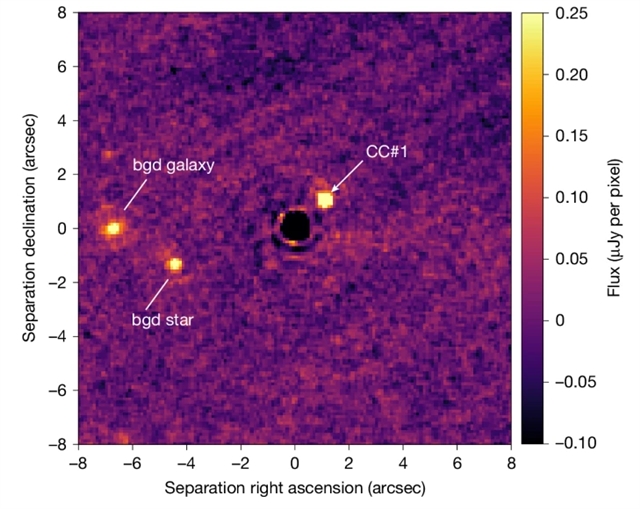
法国巴黎城市大学A.-M. Lagrange团队在年轻的TWA 7圆盘上发现了一颗亚木星行星的证据。该项研究成果发表在2025年6月25日出版的《自然》杂志上。
行星被认为是由原行星盘中的尘埃和气体形成的,碎片盘是行星形成的残留物。碎片盘的年龄从几百万年到几十亿年不等,已经失去了原始气体,它们的尘埃是由较大的岩石体之间的稳态碰撞产生的。通过光学和近红外或(亚)毫米干涉仪的高空间分辨率、高对比度成像仪,已经分辨出数十个碎片盘,其大小可达数十个天文单位,有时可达数百个天文单位。它们通常显示出空腔、环状结构和间隙,这些通常被视为行星存在的间接特征,这些行星与看不见的星子发生引力相互作用。
然而,目前还没有发现产生这些特征的行星,这可能是因为詹姆斯·韦伯太空望远镜之前的高对比度成像仪器灵敏度有限(通常为2-10 MJ)。研究组利用詹姆斯·韦伯太空望远镜的中红外仪器在热红外波段前所未有的灵敏度,在大约6.4年前的TWA 7恒星的盘面上寻找这样的行星。由于其磁极方向,这个三环碎片盘确实非常适合这种检测。研究组在距离恒星1.5角秒处明确探测到一个天体,该天体最合理的解释是一颗低温、低于木星质量的行星。其估算质量(约0.3倍木星质量)和位置(经退投影处理后约52天文单位)能够充分解释主盘结构的成因。
附:英文原文
Title: Evidence for a sub-Jovian planet in the young TWA 7 disk
Author: Lagrange, A.-M., Wilkinson, C., Mlin, M., Boccaletti, A., Perrot, C., Matr, L., Combes, F., Beust, H., Rouan, D., Chomez, A., Milli, J., Charnay, B., Mazevet, S., Flasseur, O., Olofsson, J., Bayo, A., Kral, Q., Carter, A., Crotts, K. A., Delorme, P., Chauvin, G., Thebault, P., Rubini, P., Kiefer, F., Radcliffe, A., Mazoyer, J., Bodrito, T., Stasevic, S., Langlois, M.
Issue&Volume: 2025-06-25
Abstract: Planets are thought to form from dust and gas in protoplanetary disks, with debris disks being the remnants of planet formation. Aged a few million up to a few billion years, debris disks have lost their primordial gas, and their dust is produced by steady-state collisions between larger, rocky bodies1,2. Tens of debris disks, with sizes of tens, sometimes hundreds, of astronomical units have been resolved with high-spatial-resolution, high-contrast imagers at optical and near-infrared or (sub)millimetre interferometers3,4. They commonly show cavities, ring-like structures and gaps, which are often regarded as indirect signatures of the presence of planets that gravitationally interact with unseen planetesimals2,5. However, no planet responsible for these features has been detected yet, probably because of the limited sensitivity (typically 2–10MJ) of high-contrast imaging instruments (see, for example, refs. 6,7,8,9) before the James Webb Space Telescope. Here we have used the unprecedented sensitivity of the James Webb Space Telescope’s Mid-Infrared Instrument10,11 in the thermal infrared to search for such planets in the disk of the approximately 6.4-Myr-old star TWA7. With its pole-on orientation, this three-ring debris disk is indeed ideally suited for such a detection. We unambiguously detected a source 1.5arcsec from the star, which is best interpreted as a cold, sub-Jupiter-mass planet. Its estimated mass (about 0.3MJ) and position (about 52au, de-projected) can thoroughly account for the main disk structures.
DOI: 10.1038/s41586-025-09150-4
Source: https://www.nature.com/articles/s41586-025-09150-4
Nature:《自然》,创刊于1869年。隶属于施普林格·自然出版集团,最新IF:69.504
官方网址:http://www.nature.com/
投稿链接:http://www.nature.com/authors/submit_manuscript.html
